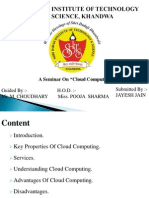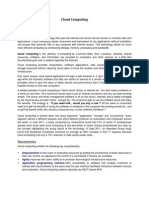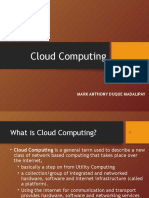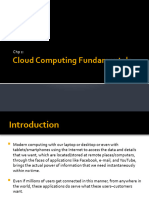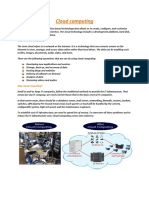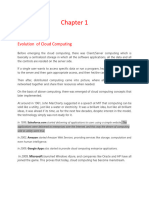0 ratings 0% found this document useful (0 votes) 9 views 7 pages Unit 2 CC
The document outlines the fundamentals of cloud computing, including its motivations, definitions, and essential characteristics such as scalability, agility, and data security. It describes the need for cloud computing in terms of convenience, cost savings, and reliability, and explains various cloud service models (IaaS, PaaS, SaaS) and deployment models (public, private, community, hybrid). Additionally, it highlights the principles of cloud computing and the advantages of using cloud services for businesses and individuals.
AI-enhanced title and description
Copyright
© © All Rights Reserved
We take content rights seriously. If you suspect this is your content,
claim it here .
Available Formats
Download as PDF or read online on Scribd
Go to previous items Go to next items
UNIT-IL
Cloud Computing Fundamentals: Motivation for Cloud Computing, The Need for Cloud
Computing, Defining Cloud Computing, Definition of Cloud computing, Cloud Computing Is a
Service, Cloud Computing Is a Platform, Principles of Cloud computing, Five Essential
Characteristics, Four Cloud Deployment Models
1, Motivation for Cloud Computing:
‘The main motivation behind cloud computing is to enable businesses to get access to data centers and
‘manage tasks from a remote location.
Cloud computing is very economical and saves a lot of money. A blind benefit of this computing is that
even if we lose our lapiop or due to some crisis our personal computer—and the desktop system—gets
damaged, still our data and files will stay sale and secured as these are not in our local machine.
Scalability
Because a desktop cloud is located in a central data center, I can easily scale its capacity and performance
by only adding new hardware.
Agility
Deployment of new desktops is @ matter of seconds, because they are virtually created in the data-center’s
infrastructure. If companies tend to grow through acquisitions and frequently require a high number of
new users to be equipped with the standard desktop platform, agility can be a valuable advantage over
traditional PC rollout.
Availability
‘The desktop cloud infrastructure is based on server hardware and usually runs in a data center, leveraging
fault-tolerant components and systems management. Thin clients used as end-user devices are without
configuration and without locally stored data; if they fal, they can be exchanged quickly and easily.
Accessibility
A central desktop in a desktop cloud can be accessed from almost any device and from almost anywhere
in the world. The only requirement is a capable network connection. But not only the desktop can be
ed from anywhere, also the user’s personal and corporate data.
4�Performance
As mentioned earlier, virtual desktops run on server hardware, Under normal mode of operation, a
number of users share a certain server hardware. Depending on the ratio of concurrent users to server
hardware, performance can be controlled, and adapted as required. Access to data is also usually much
faster, because desktop and data are both located in the data center, connected through @ high-
performance data-center network,
Data safety and security
Data can easily be backed up, compared to the number of local hard drives in traditional PCs. Regarding
data security, by keeping the data on storage devices in the data center, the data is protected by the data-
center security mechanism. The user, regardless of which country that user might sit, can only view and
edit the data, but not copy the data
2. The Need for Cloud Computing
‘The main reasons for the need and use of cloud computing are convenience and reliability. The cloud also
‘makes it much easier to share a file with friends, making it possible to collaborate over the web. While
using the cloud, losing our datafile is much less.
‘+ One of the major reason why huge number of small scale and large scale business sectors from all
over the world are using cloud today, is because of tremendous effect on cost saving. Yes, Cloud
computing has made drastic change in the reduction of hardware and software cost and other
server resources as well
‘+ We can run all our workload data of applications and processes online over the intemet remotely
instead of using physical hardware and software
‘+ Day to day issues related to server maintenance or installation of software/ hardware or whether it
is renewal of license, all those factors are undertaken via cloud computing service providers
‘+ With the help of cloud we ean access any data, applications whenever and wherever we want to,
over the internet. 100 of pre-configured applications can be install and updated
‘+ Cloud not only handles data storage remotely but it also protects and recovers all crashed or loss,
data, so we don’t have to worry about crashed or loss of data, it gives you high security
3. Defining Cloud Computing
Cloud computing means storing and accessing data and programs over the Internet from a remote location
‘or computer instead of our computer's hard drive. This so called remote location has several properties
such as scalability, elasticity etc., which is significantly different from a simple remote machine.
4, Definition of Cloud computing
Cloud computing is a model for enabling ubiquitous, convenient, on-demand network access to a shared
pool of configurable computing resources (c.g., networks, servers, storage, applications, and services) that
‘can be rapidly provisioned and released with minimal management effort or service provider interaction.
15�5, Cloud Computing is a Service
The simplest thing that any computer docs is allow us to store and retrieve information, We can store our
family photographs, our favorite songs, or even save movies on it, which is also the most basic service
offered by cloud computing
Let us look at the example of a popular application called Flickr
While Flickr started with an emphasis on sharing photos and images, it has emerged as a great place to
store those images. In many ways, itis superior to storing the images on your computer
1, First, Flickr allows us to easily access our images no matter where we are or what type of
device we are using. While we might upload the photos of our vacation from our home
computer, later, we can easily access them from our laptop at the office.
2. Second, Flickr lets us share the images. There is no need to burn them to a CD or save
them on a flash drive. We can just send someone our Flickr address to share these photos
or images,
3. Third, Flickr provides data security. By uploading the images to Flickr, we are providing
ourselves with data security by ereating a backup on the web. And, while itis always best
to keep a local copy— either on a computer, a CD, or a flash drive—the truth is that we
are far more likely to lose
6. Cloud Computing Is a Platform
The World Wide Web (WWW) can be considered as the operating system for all our Internet-based
applications. However, one has to understand that we will always need a local operating system in our
computer to access web based applications.
The basic meaning of the term platform is that itis the support on which applications run or give results
to the users. For example, Microsoft Windows is a platform, But, a platform does not have to be an
‘operating system. Java is a platform even though it is not an operating system.
Through cloud computing, the web is becoming a platform, With trends (applications) such as Office 2.0,
‘more and more applications that were originally available on desktop computers are now being converted
into web-cloud applications. Word processors like Buzzword and office suites like Google Does are now
available in the cloud as their desktop counterparts. All these kinds of trends in providing applications via
the cloud are tuming cloud computing into a platform or to act as a platform
16�7. Principles of Cloud computing
Characteristics:
Cloud computing has five essential characteristics,
1, On-demand self-service: A consumer can unilaterally provision computing capabilities, such as server
time and network storage, as needed automatically without requiring human interaction with cach
service's provider.
2, Broad network access: Capabilities are available over the network and accessed through standard
mechanisms that promote use by heterogeneous thin or thick client platforms (e.g., mobile phones,
laptops, and personal digital assistants [PDAs
3. Elastic resource pooling: The provider's computing resources are pooled to serve multiple consumers
using a multitenant model, with different physical and virtual resources dynamically assigned and
reassigned according to consumer demand, There is a sense of location independence in that the customer
generally has no control or knowledge over the exact location of the provided resources but may be able
to specify the location at a higher level of abstraction (¢.g., country, state, or data center). Examples of
resources include storage, processing, memory, and network bandwidth.
4, Rapid elasticity: Capabilities can be rapidly and elastically provisioned, in some cases automatically,
to quickly scale out and rapidly released to quickly scale in. To the consumer, the capabilities available
for provisioning often appear to be unlimited and can be purchased in any quantity at any time.
5, Measured service: Cloud systems automatically control and optimize resource use by leveraging a
metering capability at some level of abstraction appropriate to the type of service (e.g., storage,
processing, bandwidth, and active user accounts). Resource usage can be monitored, controlled, and
reported providing transparency for both the provider and consumer of the utilized service
Four Cloud Deployment Models:
Deployment models describe the ways with which the cloud services can be deployed or made available
to its customers, depending on the organizational structure and the provisioning location. One can
‘understand it in this manner too: cloud (Internet)-based computing resources—that is, the locations where
data and services are acquired and provisioned to its customers— can take various forms. Four
deployment models are usually distinguished, namely, public, private, community, and hybrid cloud
service usage
1, Private cloud: The cloud infrastructure is provisioned for exclusive use by a single organization
comprising multiple consumers (e.g., business units). It may be owned, managed, and operated by
the organization, a third party, or some combination of them, and it may exist on or off premises.
2. Public cloud: The cloud infrastructure is provisioned for open use by the general public. It may
be owned, managed, and operated by a business, academic, or government organization, or some
combination of them. It exists on the premises of the cloud provider.
3. Community cloud: The cloud infrastructure is shared by several organizations and supports a
specific community that has shared concerns (e.g., mission, security requirements, policy, and
7�compliance considerations). It may be managed by the organizations or a third party and may
exist on premise or off premise
4, Hybrid cloud: The cloud infrastructure is a composition of two or more distinct cloud
infrastructures (private, community, or public) that remain unique entities but are bound together
by standardized or proprietary technology that enables data and application portability (e.g., cloud
bursting for load balancing between clouds)
There are the following three types of cloud service models -
1. Infrastructure as a Service (laa)
2. Platform as a Service (PaaS)
3. Software as a Service (SaaS)
Infrastructure as a Service (IaaS)
IaaS is also known as Hardware as a Service (HaaS). It is a computing infrastructure managed over the
intemet. The main advantage of using IaaS is that it helps users to avoid the cost and complexity of
purchasing and managing the physical servers.
Characteristics of IaaS
There are the following characteristics of laaS -
o Resources are available as a service
9 Services are highly scalable
© Dynamic and flexible
© GULand API-based access
Automated administrative tasks
(AWS), Microsoft Azure, Google Compute
Engine (G
18�Platform as a Service (PaaS)
PaaS cloud computing platform is created for the programmer to develop, test, run, and manage the
applications.
Characteristics of PaaS
‘There are the following characteristics of PaaS -
‘9 Accessible to various users via the same development application,
‘© Integrates with web services and databases.
© Builds on virtualization technology, so resources can et
organization's need.
ily be scaled up or down as per the
© Support multiple languages and frameworks,
© Provides an ability to "Auto-scale”
Example: AWS Elastic Beanstalk, Windows Azure, Heroku, Force.com, Google App Engine, Apache
Stratos, Magento Commerce Cloud, and OpenShift
Software as a Service (SaaS)
SaaS is also known as "on-demand software”. It is a software in which the applications are hosted by a
cloud service provider. Users ean access these applications with the help of internet connection and web
browser.
Characteristics of SaaS
There are the following characteristics of SaaS -
© Managed from a central location
© Hosted on a remote server
© Accessible over the internet
©. Users are not responsible for hardware and software updates. Updates are applied automatically.
co The services are purchased on the pay-as-per-use basis,
Slack,
19�Difference between IaaS, PaaS, and SaaS
TaaS
It provides a virtual data center to
store information and create
platforms for app development,
testing, and deployment.
It provides access to resources
such as virtual machines, virtual
storage, etc
It is used by network architects,
TaaS provides only Infrastructure.
Paas
It provides virtual platforms and
tools to create, test, and deploy
apps.
It provides runtime environments
and deployment tools for
applications.
Itis used by developers.
PaaS provides
Infrastructure Platform,
SaaS
It provides web software and
apps to complete business
tasks.
It provides software as a
service to the end-users.
Itis used by end users.
SaaS provides
Infrastructure | Platform,
++Software,
20













